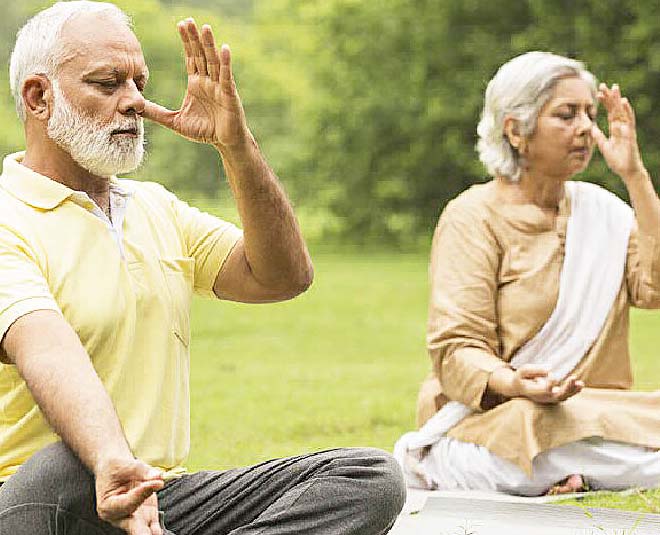Senior Yoga Trainer Course:-
a Senior Yoga Trainer Course offered at a price of 2500 without more specific information about the course and the organization offering it. It is important to thoroughly research any yoga teacher training course before enrolling in it, as there are many different types of training programs available, and the quality and content of each can vary greatly.

Some questions to consider when evaluating a yoga teacher training program include:
- Is the program accredited by a reputable yoga organization?
- Who are the instructors leading the program, and what are their qualifications and experience?
- What is the curriculum and how many hours of training are included?
- What is the format of the program (in-person, online, hybrid)?
- What is the total cost of the program, and are there any additional expenses (such as books or materials) that need to be factored in?
It is also important to remember that becoming a senior yoga trainer requires a significant amount of experience and training beyond a basic teacher training program. It is a lifelong journey of learning and growth in the practice of yoga.
While becoming a certified yoga instructor can be a positive and rewarding experience, it’s important to consider potential negative aspects as well. Here are some potential drawbacks to pursuing a yoga instructor course:
- Cost: Yoga teacher training programs can be expensive, with some programs costing several thousand dollars. This can be a significant financial investment, particularly if you’re not sure whether you’ll be able to make a career as a yoga instructor.
- Time commitment: Many yoga teacher training programs are intensive, requiring a significant time commitment over several weeks or months. This can be challenging if you have other responsibilities, such as a full-time job or caring for children.
- Physical demands: Teaching yoga can be physically demanding, particularly if you’re teaching multiple classes per day or working with students who have injuries or limitations. It’s important to take care of your own body and avoid burnout.
- Competitive job market: Depending on where you live, the job market for yoga instructors may be competitive. It can be challenging to build a sustainable career as a yoga instructor, particularly if you’re just starting out.
- Limited earning potential: Even if you’re able to find regular teaching work, the earning potential for yoga instructors may be limited. It can be difficult to make a comfortable living solely as a yoga instructor.
It’s important to weigh the potential benefits and drawbacks of pursuing a yoga instructor course before making a decision. Consider your personal goals and circumstances, and talk to other yoga instructors to get a sense of what the job market is like in your area.

It is important to thoroughly research any yoga teacher training course before enrolling in it, as there are many different types of training programs available, and the quality and content of each can vary greatly.
In general, becoming a senior yoga trainer requires years of dedicated study and practice, as well as advanced training and education beyond a basic teacher training program. It is a lifelong journey of learning and growth in the practice of yoga, and requires a deep understanding of anatomy, physiology, philosophy, and teaching techniques. Before enrolling in any yoga teacher training program, it is important to carefully consider your goals and objectives, as well as the qualifications and experience of the instructors leading the program.
Conduct the Advanced Yoga sessions and train the Yoga Instructors Senior Yoga trainer Course:-
Bal Yoga can provide numerous benefits for children, including:
- Improved Physical Health: Bal Yoga can help children develop greater strength, flexibility, coordination, and balance. This can help prevent injuries and improve overall physical health.
- Enhanced Emotional Well-being: Bal Yoga can help children develop greater self-awareness, self-esteem, and self-confidence. It can also help children manage stress, anxiety, and other emotional challenges.
- Increased Focus and Concentration: Bal Yoga can help children develop greater mental clarity, focus, and concentration. This can improve academic performance and other areas of life that require concentration and attention.
- Improved Social Skills: Bal Yoga can help children develop greater empathy, compassion, and communication skills. It can also help children learn how to work cooperatively with others and develop a sense of community.
When looking for an advanced Bal Yoga program, it is important to find a qualified instructor who has experience working with children and teaching yoga. The cost of an advanced Bal Yoga program may vary depending on the location, format, and level of instruction provided. It is important to research different programs and compare their costs and benefits to find one that is right for your child’s needs and interests.
Yoga can be an excellent form of exercise and wellness practice for seniors, with many potential benefits, including:
- Improved flexibility and balance: Yoga poses and movements can help improve joint mobility and increase flexibility, which can reduce the risk of falls and injuries. Regular practice can also improve balance and stability.
- Reduced stress and anxiety: Yoga includes breathing exercises and meditation practices that can help calm the mind and reduce stress and anxiety. This can have positive effects on overall well-being and mood.
- Increased strength and endurance: Many yoga poses require holding a specific posture, which can help build strength and endurance in the muscles. This can be particularly beneficial for seniors, who may be at risk for muscle loss and weakness.
- Improved sleep: Regular yoga practice has been shown to improve sleep quality and duration, which can have numerous positive effects on overall health and well-being.
As for the cost of a Senior Yoga Trainer Course, it’s important to note that this type of training is typically geared towards experienced yoga teachers who are looking to deepen their knowledge and skills. While completing such a course may provide additional benefits to seniors who practice yoga, it may not be necessary or appropriate for all individuals. It’s also worth noting that the cost of such a course can vary widely depending on the program and location, and may be significantly more

A Senior Yoga Trainer Course is a specialized training program designed for experienced yoga teachers who are looking to deepen their knowledge and skills. These courses are typically focused on advanced yoga techniques, philosophy, anatomy, and teaching methodology.
The specific curriculum and requirements for a Senior Yoga Trainer Course may vary depending on the program and location, but some common features may include:
- Advanced yoga postures and techniques: Senior Yoga Trainer Courses typically include instruction on more advanced yoga postures and movements, as well as variations and modifications to adapt to different levels of ability.
- Yoga philosophy and history: These courses may include lectures and discussions on the history and philosophy of yoga, as well as its cultural and spiritual significance.
- Anatomy and physiology: Senior Yoga Trainer Courses may include instruction on human anatomy and physiology as it relates to yoga practice, including the musculoskeletal and nervous systems.
- Teaching methodology: These courses may also provide instruction on advanced teaching techniques, including sequencing, adjustments, and modifications.
Completion of a Senior Yoga Trainer Course can lead to certification as a Senior Yoga Teacher, which may enhance a teacher’s professional credentials and reputation. It can also provide opportunities for advanced teaching positions and specialized workshops or retreats.
It’s important to research and carefully consider any Senior Yoga Trainer Course before enrolling, to ensure that it meets your needs and is taught by experienced and qualified instructors. The cost of such a course can vary widely depending on the program and location.
It is important to thoroughly research any yoga teacher training course before enrolling in it, as there are many different types of training programs available, and the quality and content of each can vary greatly.
In general, becoming a senior yoga trainer requires years of dedicated study and practice, as well as advanced training and education beyond a basic teacher training program. It is a lifelong journey of learning and growth in the practice of yoga, and requires a deep understanding of anatomy, physiology, philosophy, and teaching techniques. Before enrolling in any yoga teacher training program, it is important to carefully consider your goals and objectives, as well as the qualifications and experience of the instructors leading the program.

Becoming a senior yoga trainer typically involves the following process:-
- Obtain a yoga teacher certification: To become a yoga trainer, you need to complete a yoga teacher certification program from a recognized yoga school or institution. These programs can range in duration from a few weeks to several months or even years, depending on the level of certification you are seeking.
- Gain teaching experience: After obtaining your certification, it’s important to gain experience teaching yoga. You can gain experience by teaching at yoga studios, community centers, gyms, or by offering private lessons.
- Specialize in senior yoga: To become a senior yoga trainer, you need to specialize in teaching yoga to older adults. This involves understanding the unique physical and psychological needs of seniors, and modifying yoga practices accordingly.
- Continuously educate yourself: To maintain your senior yoga trainer certification, you will need to participate in continuing education programs and workshops. This will help you stay up-to-date with the latest yoga practices and techniques, and ensure that you are providing the best possible guidance to your students.
- Build a reputation: Finally, building a reputation as a senior yoga trainer requires dedication, hard work, and a commitment to your students’ well-being. This involves establishing yourself as a respected and knowledgeable teacher, and providing high-quality instruction that helps your students achieve their goals.
- While becoming a certified yoga instructor can be a positive and rewarding experience, it’s important to consider potential negative aspects as well. Here are some potential drawbacks to pursuing a yoga instructor course:
- Cost: Yoga teacher training programs can be expensive, with some programs costing several thousand dollars. This can be a significant financial investment, particularly if you’re not sure whether you’ll be able to make a career as a yoga instructor.
- Time commitment: Many yoga teacher training programs are intensive, requiring a significant time commitment over several weeks or months. This can be challenging if you have other responsibilities, such as a full-time job or caring for children.
- Physical demands: Teaching yoga can be physically demanding, particularly if you’re teaching multiple classes per day or working with students who have injuries or limitations. It’s important to take care of your own body and avoid burnout.
- Competitive job market: Depending on where you live, the job market for yoga instructors may be competitive. It can be challenging to build a sustainable career as a yoga instructor, particularly if you’re just starting out.
- Limited earning potential: Even if you’re able to find regular teaching work, the earning potential for yoga instructors may be limited. It can be difficult to make a comfortable living solely as a yoga instructor.
- It’s important to weigh the potential benefits and drawbacks of pursuing a yoga instructor course before making a decision. Consider your personal goals and circumstances, and talk to other yoga instructors to get a sense of what the job market is like in your area.

If you’re interested in becoming a senior yoga trainer, here are some general guidelines to follow:-
- Start by obtaining a yoga teacher certification from a recognized yoga school or institution. Look for programs that specialize in teaching yoga to seniors, or offer coursework on modifying yoga practices for older adults.
- Gain teaching experience by working with older adults, either by teaching specialized senior yoga classes or by offering private lessons. This will help you develop your skills and gain a better understanding of the unique needs and challenges of older yoga students.
- Continue your education by attending workshops and training programs that focus on senior yoga. This will help you stay up-to-date with the latest research, techniques, and best practices in the field.
- Build a strong network of contacts in the yoga community, including other teachers, studio owners, and organizations that serve older adults. This can help you find new teaching opportunities and build your reputation as a senior yoga trainer.
- Stay attuned to the needs of your students, and be willing to modify your teaching approach to meet their individual needs and abilities. This may involve adapting poses or sequences to accommodate physical limitations, or incorporating meditation or relaxation techniques to help students cope with stress and anxiety.
- Finally, always prioritize safety in your teaching, especially when working with older adults who may be more vulnerable to injury. Make sure you are familiar with common health conditions and physical limitations that may affect your students, and be prepared to modify your instruction accordingly.
- While becoming a certified yoga instructor can be a positive and rewarding experience, it’s important to consider potential negative aspects as well. Here are some potential drawbacks to pursuing a yoga instructor course:
- Cost: Yoga teacher training programs can be expensive, with some programs costing several thousand dollars. This can be a significant financial investment, particularly if you’re not sure whether you’ll be able to make a career as a yoga instructor.
- Time commitment: Many yoga teacher training programs are intensive, requiring a significant time commitment over several weeks or months. This can be challenging if you have other responsibilities, such as a full-time job or caring for children.
- Physical demands: Teaching yoga can be physically demanding, particularly if you’re teaching multiple classes per day or working with students who have injuries or limitations. It’s important to take care of your own body and avoid burnout.
- Competitive job market: Depending on where you live, the job market for yoga instructors may be competitive. It can be challenging to build a sustainable career as a yoga instructor, particularly if you’re just starting out.
- Limited earning potential: Even if you’re able to find regular teaching work, the earning potential for yoga instructors may be limited. It can be difficult to make a comfortable living solely as a yoga instructor.
- It’s important to weigh the potential benefits and drawbacks of pursuing a yoga instructor course before making a decision. Consider your personal goals and circumstances, and talk to other yoga instructors to get a sense of what the job market is like in your area.
- While becoming a certified yoga instructor can be a positive and rewarding experience, it’s important to consider potential negative aspects as well. Here are some potential drawbacks to pursuing a yoga instructor course:
- Cost: Yoga teacher training programs can be expensive, with some programs costing several thousand dollars. This can be a significant financial investment, particularly if you’re not sure whether you’ll be able to make a career as a yoga instructor.
- Time commitment: Many yoga teacher training programs are intensive, requiring a significant time commitment over several weeks or months. This can be challenging if you have other responsibilities, such as a full-time job or caring for children.
- Physical demands: Teaching yoga can be physically demanding, particularly if you’re teaching multiple classes per day or working with students who have injuries or limitations. It’s important to take care of your own body and avoid burnout.
- Competitive job market: Depending on where you live, the job market for yoga instructors may be competitive. It can be challenging to build a sustainable career as a yoga instructor, particularly if you’re just starting out.
- Limited earning potential: Even if you’re able to find regular teaching work, the earning potential for yoga instructors may be limited. It can be difficult to make a comfortable living solely as a yoga instructor.
- It’s important to weigh the potential benefits and drawbacks of pursuing a yoga instructor course before making a decision. Consider your personal goals and circumstances, and talk to other yoga instructors to get a sense of what the job market is like in your area.









